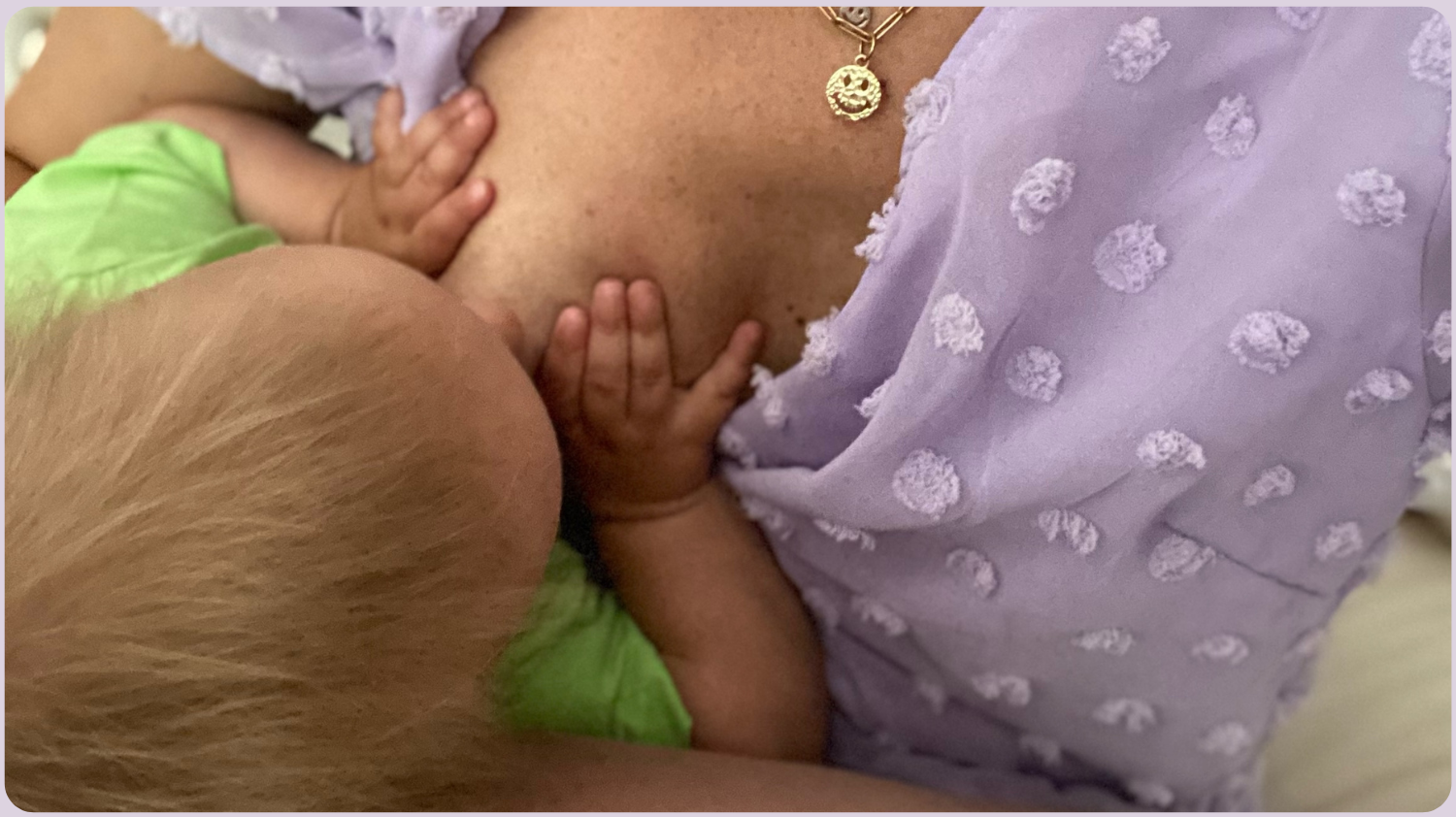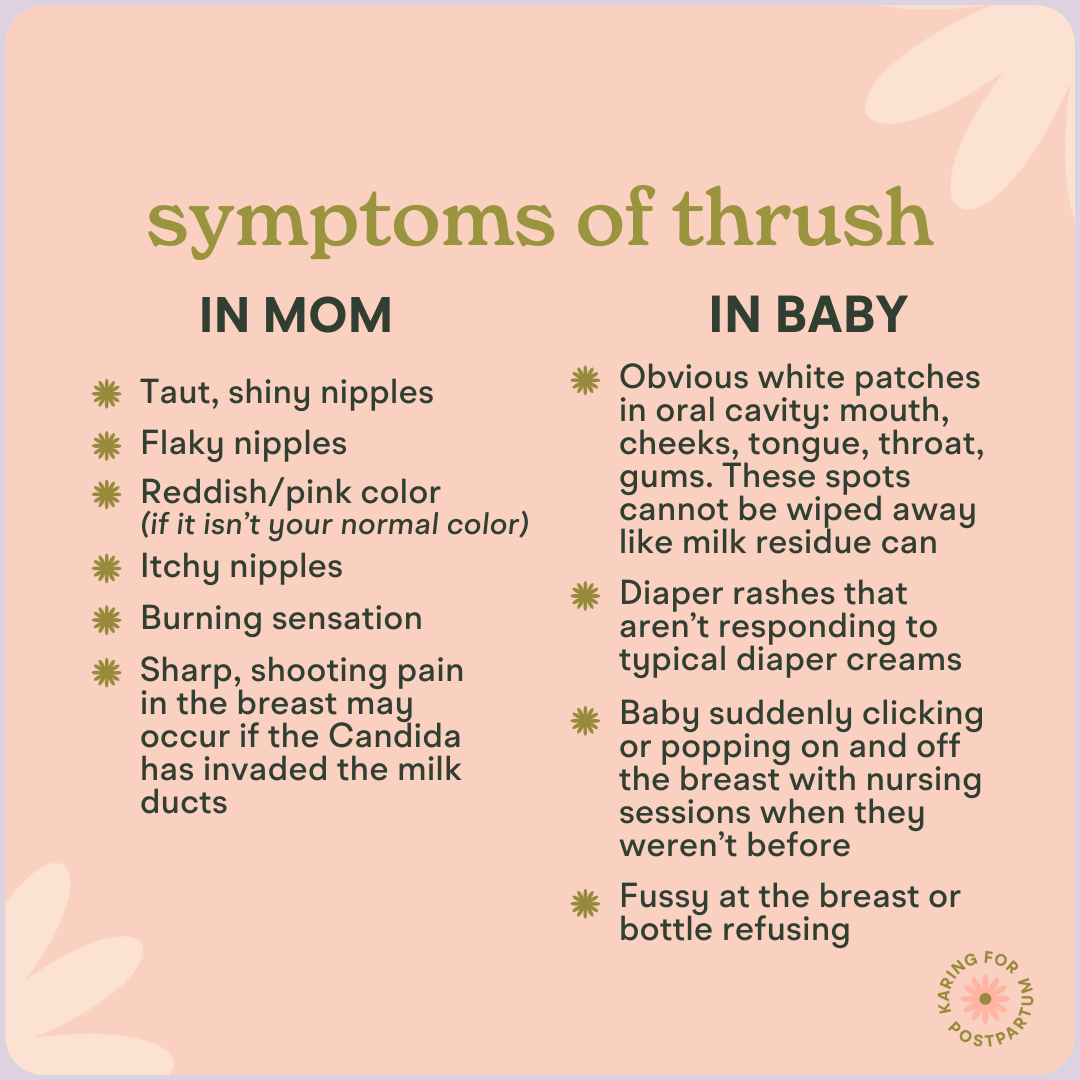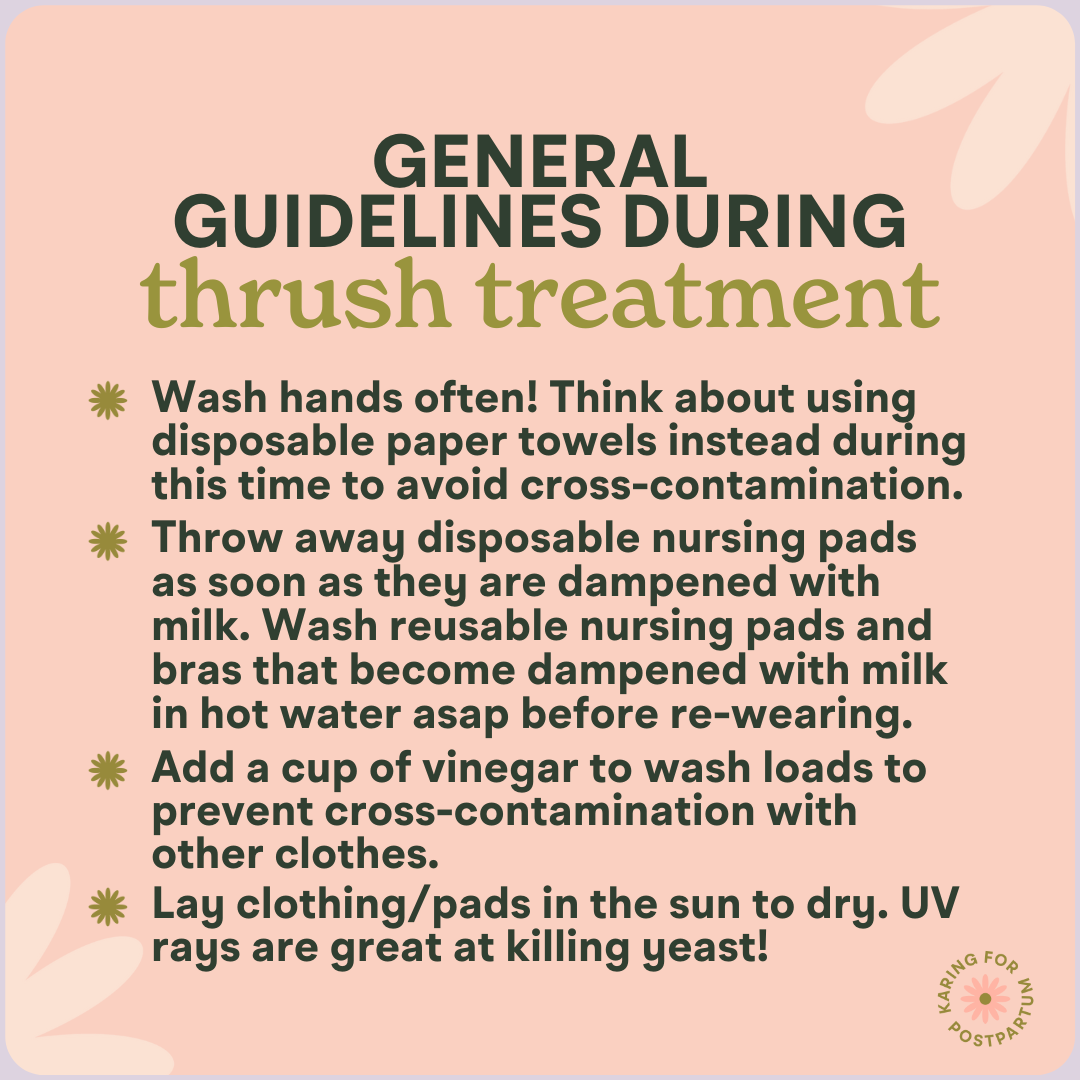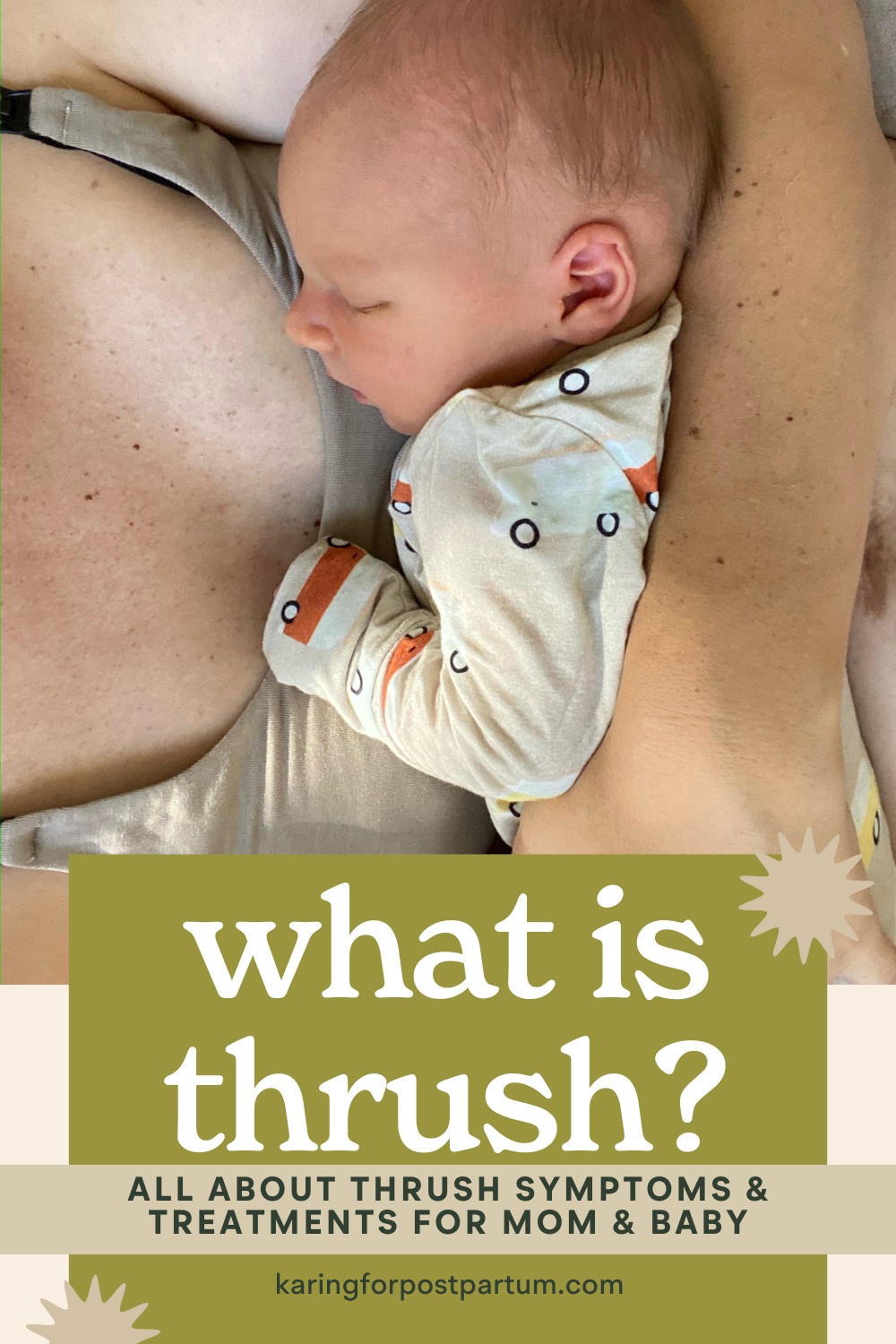what is thrush?
Thrush is a fungal/yeast infection, also known as Candida, that thrives in warm, moist environments.
In other words, it is an overgrowth of yeast!
Baby’s mouth, mom’s nipples, vaginas, diaper areas for baby, etc are all perfect breeding grounds for thrush. It can affect baby's oral cavity and/or mom’s nipples when breastfeeding. It is easily transferred back and forth if both parties are not appropriately treated.
Although not *always* the case, thrush is typically something that comes on pretty abruptly, and it often comes after a period of “good nursing”. No amount of repositioning or readjusting the latch is going to make the thrush pain go away!
I’m going to talk more about symptoms to look out for, a few predisposing factors, as well as treatment options and how to handle milk storage during thrush!
Let’s go!
SYMPTOMS
Symptoms are of course going to vary from person to person! It’s important to consult with your LC if you feel you have thrush, as it can be easily confused with vasospasms as well.
I want to note that with thrush, mom may show symptoms, but baby may not show obvious signs or may even be asymptomatic and it can still be present. This was the case for me!
Baby may not have the typical white spots in their mouth, yet may be extra fussy or gassy while mom displays common symptoms like burning, itching, redness, shiny nipples, etc. We’ll talk about this more when we talk about treatment options, but it’s important to watch your body if you feel like something is “off”.
When getting a thrush diagnosis, it’s very important to go through every symptom and history with whoever is “diagnosing” it. You really need a complete history to accurately diagnose it as well as coming up with the proper treatment.
Thrush is so often misdiagnosed, so it’s important to be extremely thorough in your conversation with your provider. It’s very important that you assess every symptom as a whole to get the care that you need!
Here are some common symptoms to be on the lookout for, though:
In Mom (thrush of the nipple)
Taut, shiny nipples
Flaky nipples
Reddish/pink color (more noticeable if it isn’t your normal color)
Itchy nipples
Burning sensation with nursing
Sharp, shooting pain in the breast may occur if the Candida has invaded the milk ducts
In Baby
Obvious white patches in oral cavity: mouth, cheeks, tongue, throat, gums. These spots cannot be wiped away like milk residue can.
Diaper rashes that aren’t responding to typical diaper creams. Maybe you’ve tried using your usual diaper creams and they don’t seem to be working, or maybe it’s getting worse or redder, or more “angry” looking.
Baby suddenly clicking while feeding or popping on and off the breast/bottle with feeding sessions, when they weren’t before.
Fussy at the breast or bottle refusing.
PREDISPOSING FACTORS
These factors may put you at a higher risk for a fungal infection or thrush.
BUT just because you have or experience any of these things does not mean you will get thrush! It just means you are at a higher risk for developing it.
In Mom
Frequent or current vaginal yeast infection
Antibiotics administered recently – This includes the antibiotics that are administered during labor if GBS+, c-section, or premature rupture of membranes. Though these are necessary, it *can in some* cases increase risk for thrush.
Long-term steroid use in mom
Nipple trauma – Allows easy entry to nipple
Oral contraceptive use
Damp nursing pads – This provides a warm, moist environment for yeast to grow
Diabetes in mother
Anemia
Excessive intake of dairy products and sweets
In Baby
Antibiotic administration
Long-term steroid administration
Passed from Mom
Antibiotics
This is one of the biggest predisposing factors, so let’s dive into a bit.
Antibiotics are medications that are designed to kill off “bad bacteria”. However, antibiotics don’t actually differentiate between good and bad bacteria and will also kill off the good/protective bacteria that our bodies need. Without the good/protective bacteria fighting and regulating the bad bacteria, an overgrowth of yeast can occur.
Though the benefits of taking an antibiotic most often outweigh the risks (especially when they’re being administered in labor for reasons mentioned above!!), it’s important to know their impact and how to replenish those good bacteria during and after a round of antibiotics. We’ll talk about that next in the treatment section.
TREATMENT
Both parties must be treated if one is diagnosed but the other is asymptomatic.
That was the case for me! I had symptoms, but my baby did not have the typical white patches in his mouth or other symptoms aside from popping off when nursing. Our pediatrician was very hesitant to give him any treatment for thrush since he wasn’t presenting with typical signs, even though he was fussier at the breast and gassier than usual. Since I was already diagnosed with nipple thrush, my physician called our pediatrician to get them on board to treat Cameron as well, so we wouldn’t pass it back and forth.
Be your own advocate, as sometimes providers are hesitant to treat the asymptomatic party.
General Guidelines During Thrush Treatment
Wash hands often! Think about using disposable paper towels instead during this time to avoid cross-contamination.
Throw away disposable nursing pads as soon as they are dampened with milk. Wash reusable nursing pads and bras that become dampened with milk in hot water asap before re-wearing.
You can add a cup of vinegar to wash loads to prevent cross-contamination with other clothes.
You can lay clothing/pads in the sun to dry. UV rays are great at killing yeast!
Traditional Treatments
Continue regimen 1-2 weeks past symptoms getting better
Take full medication if on antibiotics
Nystatin
Oral Nystatin
Diflucan (Flucanazole)
All-purpose nipple ointment w/ Nystatin in it
OTC antifungal cream
Natural Remedy Options
Adding in a probiotic – This helps increase the “good bacteria” and is also a great option to start one WHILE on an antibiotic preventatively.
Garlic supplements – Garlic is a yeast fighter!
Echinacea – It’s an immune booster!
Vinegar rinses – Yeast hates an acidic environment. You can even do this before applying your antifungal nipple cream.
Grapefruit seed extract (GSE) – This is usually a capsule or oral yeast treatment.
If Baby Has a Diaper Yeast Rash
Avoid diaper wipes during this time, if at all possible. Try to use a gentle washcloth and plain water instead. Let air dry!
You can apply a cotton swab of vinegar to the affected area and let air dry during changes.
As much air time as possible! Lay a towel or pee pad down to do tummy time or hangout!
MILK STORAGE during THRUSH
Best practice not to freeze it for later. Give it fresh or within a day or two. Freezing inactivates yeast, but doesn’t kill it, so we don’t want to risk the yeast activating again later when we thaw it and warm it back up.
Here are the milk guidelines suggested during thrush treatment:
Try to only feed baby freshly expressed milk or refrigerated expressed milk
If that’s not an option, you can scald or boil the milk before freezing to kill yeast, but it can likely kill many antibodies in the milk as well
Boil bottle nipples, pacifiers, toys, and pump parts for about 20 minutes each day during treatment
I hope this has given you more insight and knowledge to help treat or prevent thrush! It can be an unpleasant experience, so be sure to seek out the help or remedies you need to take care of you and baby.
If you want to watch my full highlight on thrush, you can do that here.
You’ve got this, Mamas!
Xoxo
Karrie
Was this helpful? Save it for later or send to another mama who needs it!





